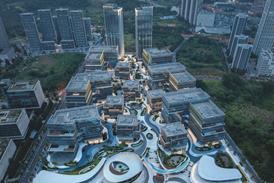Our town and city centres, with their wealth of existing buildings, provide huge opportunities to deliver new housing and foster thriving communities, writes Tom Slater

Grappling with chronic shortages of affordable housing, particularly in our urban centres, local authorities and government are looking for solutions that will fulfil the demand for housing, and deliver sustainable, successful communities for the future. This will require them to make decisions on where to build that will have far-reaching consequences for our towns and cities.
One recently proposed solution is a relaxation of the rules surrounding the development of green belt land. This perennial debate seems to have reached an inflection point, with both main parties agreeing that ‘something must be done’ and that the green belt is the cause of the lack of development and increasing house prices.
But while unlocking selected green belt tracts could cater to development demands, the ramifications on car dependency and resultant urban congestion cannot be ignored. New homes built ‘out of town’ inevitably result in increasing numbers of car journeys, roadside pollution, carbon emissions, and time lost to commuting.
The spotlight must swing back to our urban centres. They’re not just places of residence or commerce; they are the linchpins for a sustainable future. With a growing commitment to sustainability, British towns and cities are embracing emission control zones, low-traffic neighbourhoods, pedestrianisation and cycle lanes, and the concept of walking cities.
Reclaiming our urban centres back from the motor vehicle brings so many advantages, one can almost lose count: improvements in air quality, road safety and noise pollution; improved public spaces; physically and mentally healthier citizens; improved biodiversity; and a reduction in premature mortality, to name a few.
But this also means increasing population density in our urban centres, to capitalise on the economies of scale and shared infrastructure they offer. New structures will undeniably play their part in this urban tapestry, but there’s a compelling case to be made for ‘soft intensification’ - the extension and refurbishment of existing buildings to deliver more homes and commercial spaces.
In essence, it’s about rediscovering the latent potential nestled within our existing architectural heritage and leveraging the embodied carbon present in existing structures. Soft intensification offers an ‘eco-friendlier’ alternative to large-scale demolitions and construction, and dovetails with the UK’s ambitions for more green public spaces and emission control zones.
Although demolition is perhaps the only future awaiting many older buildings, there are plenty that, with the right design and construction, can be expanded and refurbished to provide many new homes where supply is low and demand is high.
This bottom-up approach may appear piecemeal, but with the right incentives it could be the perfect short and medium-term option to help alleviate housing costs in highly desirable areas, increase population density around public transport nodes, and leverage the colossal amount of carbon embodied in the fabric of our cities.
Soft intensification is a sensible, timely solution that bridges our storied architectural past with the demands of a sustainable future. It isn’t about sidelining new constructions; rather, it’s about seeking a balanced and thoughtful blend of the old and new.
And when you peek into the architectural makeup of UK towns and cities, particularly the many 20th-century mixed-use structures, you’ll quickly see there’s great potential for expansion and refurbishment. A focus on vertical expansion and reconfiguration of these buildings not only creates additional living spaces but also helps re-energise commercial districts, ensuring they remain bustling and vibrant.
But it’s not just about bricks and mortar. There’s a socio-economic dimension to soft intensification too. By rejuvenating existing structures, we’re not only breathing new life into the very heart of our urban landscapes but also supporting local businesses.
Residents of urban centres invariably translate to more patrons for cafes, retail businesses, and other services. This interplay can create thriving micro-economies, reducing the need for long commutes, fostering stronger community ties and attracting new businesses and services to the area.
Planners, architects, developers, local businesses, and the broader community must come together, united by a shared objective of sustainable urban evolution. Policy incentives, such as tax breaks or grants for refurbishing older buildings, could act as catalysts, nudging property owners towards soft intensification.
The path to sustainable urban living isn’t linear. It’s a blend of bold new ideas and a respectful nod to our past with generous helpings of technology and innovation in materials.
As the UK embarks on this journey, concepts like soft intensification can help us navigate the challenges, ensuring our urban centres remain human-scale, dynamic, and sustainable while preserving the features and buildings that give every district and place its own unique character.
Postscript
Tom Slater is founding director of T2S Architecture
















No comments yet